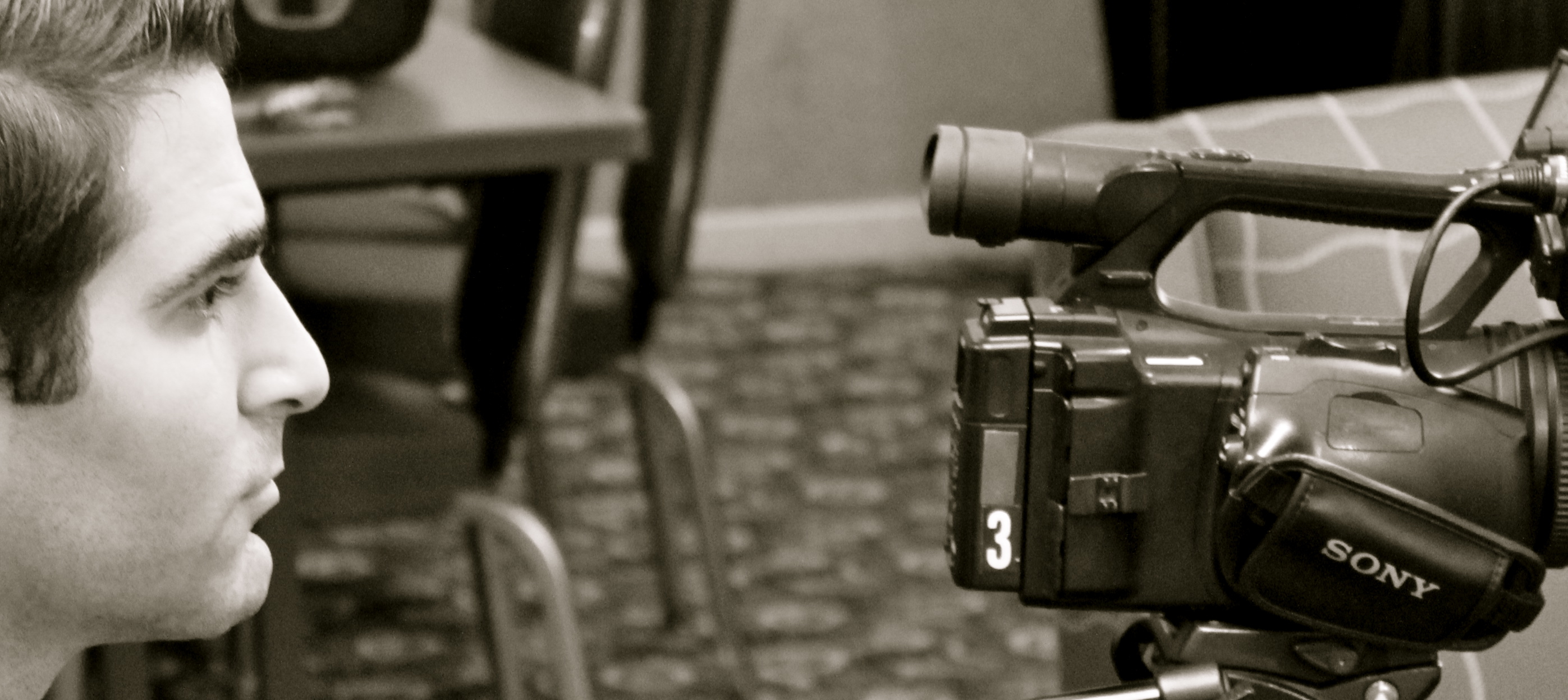“Don’t talk to strangers.”
Bet you’ve heard that one before. Who hasn’t?
From an early age, we’re instructed to avoid unfamiliar people. Don’t look at them, don’t get in a car with them, don’t walk down an alley with them — not even if they have candy. Especially if they have candy.
Well, forget that.
Talk to strangers. Seriously. Shake their hands, hear their stories, and enjoy the little quirks that make them “them.” It’s not such a strange thing to do.
This blogumn began as notebook scribble in Kansas City International Airport. As I sat in the fast-food court, watching planes go by on the Tarmac, I reflected on how I got there: More than 3,000 miles of Amtrak train travel … and a man named Jim Wells.
On Saturday, May 15, I embarked on a 12-day journey across the country and back. Starting at Philadelphia’s 30th Street Station, I stopped at Union Station in the nation’s capital before heading to another Union Station in Chicago.
Sometime before Pittsburgh, I entered the train’s dining car. “Reservation for one.” They sat me “community style” with — gasp! — strangers. My first encounter of the human kind involved Mike and Angie, a married couple from Great Britain. ‘Twas bloody lovely.
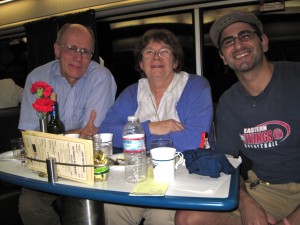
When we got to Chicago on the 16th, I met some people from South Jersey, my home turf. At a hat embroidery store I once visited while applying for colleges, the charming hat embroiderer, Tully, helped me design a “Keep It Movin” hat at Navy Pier. After sharing its meaning with her, I kept it movin’ myself.
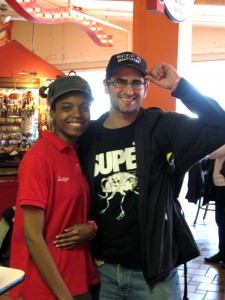
At 3:15 that afternoon, I boarded the “Southwest Chief,” heading non-stop for Los Angeles. The longest leg of my journey, we’d cover 2,256 miles in 41 hours. And I would love every minute of it.
As we crossed the Mississippi River, I started talking to a guy from Missouri. We passed by a beaver dam, and I told him it reminded me of the time my cousin, Juli, was fly-fishing and got chased by beavers. He told me it reminded him of his uncles who used to harvest marijuana.
Huh?
Long-and-insane story short: He had two uncles who grew pot together in Missouri, and one day the feds tried busting them. The men fled. One escaped by land; the other, by sea. The latter dove into the black, muddy river and swam into a beaver dam, which sufficed as a hiding place … until the beaver came home.
“So he’s sittin’ there in the beaver dam, pokin’ the animal with a sharp stick to keep it away,” my midwestern muchacho told me. “But there was no way in hell he was leavin’ his hideaway. Eventually he swam to shore, and his kid picked him up.” To this day, he proudly stated, his uncles remain free men.
Leave it to beaver, damn.
During the ride, I spent a lot of time with Octavio, a Californian who originally hailed from Mexico, and his two-year-old son, also named Octavio (aka Octavio Dos or Octavio También).
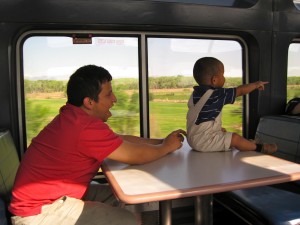
Then I met E-Ro, the only person taking more pictures than my geeky self. I played a song by Silvertide, entitled “California Rain,” for her. “I brought my rain to California,” the lyrics go, “All the way from Philadelphia, PA.” When we arrived in The City of Angels, it rained.
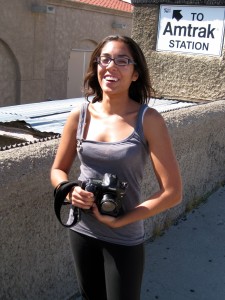
“It’s because you played that song!” E-Ro said. I like to think so.
My last evening in Los Angeles, I met a guy named Arul in a bar. “You’re from New Jersey?” he asked me — a typical let’s-not-be-strangers-anymore question to ask. “Whereabouts?”
“Voorhees,” I replied. “It’s a little town near Cherry Hill … you’ve probably never heard o—”
“Dude!” he interrupted me. “I went to Eastern!”
Eastern — my high school. I traveled 3,000 miles from home to meet someone who owns the same yearbook. Later in the night, we ran into a guy who played ice hockey in our town, and we saw a California license plate that read, “NJFRESH.” Ain’t that strange.
Post-writing note: One day, I received an email from a guy named Wes, who wrote, “I am the guy with the NJFRESH license plate … Just googled (sic) it for the hell of it and your blog came up.”
On Saturday the 22nd, I re-boarded the Southwest Chief and headed for Lamy, New Mexico. I enjoyed a memorable lunch with Jon, a writer/actor/director from L.A. who wore a warm smile and a settling demeanor, and Jean, a petite, young-at-heart lady whose eyes sparkled and who had made about a dozen cross-country train trips in her life. My kind of girl.
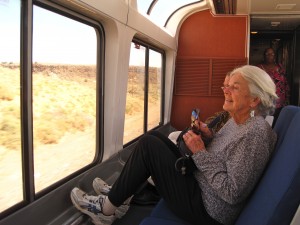
At our station stop in Albuquerque, Amanda from Riverside, Calif., shared her French fries and her story with me. I digested both.
At Harry’s Roadhouse in Santa Fé, N.M., I met a retired physicist who studied wolves in the wild, said he had stood a few precarious feet away from them without worrying. “Wolves,” he said, “just don’t attack humans.” Safer than strangers with candy.
On the way to visit my friend Lauren in Lawrence, Kan., I tried focusing intensely on my work — not taking pictures, not daydreaming, not talking to anyone. And that’s how I met Ed Robinson.
I first noticed him preaching The Gospel of Ed to a couple sitting in front of me while I toiled on my manuscript. He initially struck me as a rambling hobo, as strangers often do.
After finishing his sermons on the dangers of fluoridated water, preposterous prescription pharmaceutical prices, and KFC’s supposedly steroid-enhanced chickens, he started walking back toward his sleeping berth. Then he caught sight of me, froze, and watched me typing until I acknowledged him.
“Hi,” I tepidly greeted him.
“What’re you writing?” He nodded at the computer screen.
“I’m actually working on a book,” I said.
“You don’t say. So am I.”
I considered the tall, black man in a University of Michigan hat and matching T-shirt. He could’ve been anywhere from 50 to 80 years old. (He eventually revealed his age but told me, “That’s my secret,” and it’ll stay that way unless Ed feels like telling you, too.)
Ed Robinson is a walking fiction hero in a non-fiction world. He talks and talks, tells you story after story, and you listen and listen, captivated.
He told me about the time he tried photographing a wild rhinoceros in Africa, startled it, and ran away. He claimed his camera had run out of film, so he lacked photographic proof. He did, however, do a terrific rhino impression — grunts and snorts and sniffs and all.
Then he told me about his books-in-progress, his pursuit of a second collegiate degree at his mystery age, and his illustrious career in music. He told me to look up his CD: Ed Robinson, In a Romantic Mood.
Then he recounted his adventures in Europe — Finland, I think — where he said the women are male-hunting Amazons. “Tall!” he motioned with his hand above his head. He described a couple of his exploits with a gleam in his eye and a boyish grin on his face. In a romantic mood, indeed.
The whole time, I wondered: Is this guy for real? He told so many tall tales, I thought about calling him “Aesop.” But his stories contained so many vivid details, and they all fit together into the narrative of his life; I wasn’t sure what to think.
Upon my arrival at Lauren’s in Lawrence, I immediately Googled In a Romantic Mood. There was Ed, on the CD cover, sprawled across a grand piano and donning a yellow suit. He was smiling — at me, it seemed, for doubting him.
While crashing on Lauren in Lawrence’s couch — and fearing for my life because highly-venomous brown recluse spiders had invaded her apartment — I met Morris, Shelby, and a number of other town locals. As they say in Almost Famous, “We’re just real Topeka people, man.” Except they’re real Lawrence people, but you get the point.
I survived the evening without a spider bite and, the following morning, rode the Southwest Chief one last time to Union Station in Kansas City, Mo. Now that I’ve visited one in D.C., Chicago, L.A. and K.C., I’ve decided that Union Station must have the most original name since Bob Smith.
At “Generic Station,” a major problem confronted me: How would I get from there to Kansas City International Airport, more than a half-hour away?
The solution: Jim Wells.
Upon exiting the Southwest Chief at Union Station IV, I talked to the Amtrak information lady. “How do I get from here to the airport? Is there a shuttle?”
Her look said, “Oh boy, are you screwed.” Her mouth said, “No, there’s no shuttle. I suppose you could take a taxi, but that’s going to cost you. It’s like 25, 30 miles from here.”
Fudge. I walked toward the station exit, prepared for a billion-dollar cab ride. Then I heard a voice.
“I can take you to the airport, if you want.”
I wheeled around. A thin, older man stood before me. He had sparse, salt-and-pepper hair — more salt than pepper — with a matching mustache and silver eyeglasses. He wore a plain, gray T-shirt and light khaki shorts.
A complete and total stranger.
My previous life experiences and mental conditioning told me not to trust him, to be wary, to take the bank-busting taxi. But the man had kind eyes and ‘a real Topeka person’ tone.
“I saw you talking to the lady,” he said. “You’re trying to get to the airport?”
“Yeah …”
“I don’t mind taking you, as long as you don’t mind my dog coming along for the ride. I don’t have anything important to be doing the rest of the morning.”
Everything in me screamed, “Don’t do it, you moron. He’s a stranger — he can’t be trusted!” If I was a cat person, the dog would’ve been the deal-breaker.
Exercising caution, I told him I wanted to investigate my cab and shuttle options first. He said that was fine and even helped the process along.
The closest shuttle had just taken off from Kennedy Space Center. The taxi driver asked if I wanted to take out a loan.
Back to the stranger. “You’re sure you don’t mind taking me?” I asked him. “I feel bad putting you out like that.”
“No,” he shook his head, “I really don’t have anything important to do this morning.”
He had stuffed his hands in his short pockets, which I studied; if he was hiding a gun in them, it was the smallest gun ever made.
“Alright,” I said, “let’s go to the airport.”
And so we did. I walked with him to his car — pretty sure it was a stylish, new Volkswagen — where his peaceful puppy, Harley, panted in the back seat. We put my belongings in the trunk and started driving. My nerves remained on edge.
“I’m Sam.” I said, closing the door.
“I’m Jim Wells,” he said as we shook hands. “It’s nice to meet you, Sam.”
I texted my dad in case I was about to end up in a ditch somewhere, something along the lines of, “Hey I’m going to the airport from the train station in a car with a man named Jim Wells. If you don’t hear from me within an hour, call the cops.”
The farther we drove, though, the less I worried. Jim said he was 76 years old, a retired physician. He started telling me all kinds of information about Kansas City, a lovely place. Did you know that there’s a Kansas City in Missouri and Kansas? I didn’t, but I do now, thanks to Jim.
Once we started passing highway signs for KCI Airport, I said to myself, “Self: I don’t think this guy has any intentions of chopping you into little pieces or selling you into sex slavery.”
And of course, he didn’t. When we arrived at the airport, Jim refused to even take the money I offered him for gas. We exchanged contact information, and I headed off to my gate.
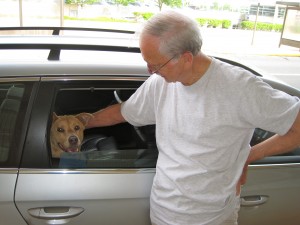
Ten minutes later, my phone started ringing. “Jim Wells,” the caller info screen read.
“Hey Jim, what’s up?”
“Hey Sam. I was just wondering — how much did they charge you to check your bag?”
I laughed. “I had to take a few things out to get it close to 50 pounds, so it was just $25. It would’ve been an extra $75 if it had been overweight.”
“Oh good,” he said, “I was worried about that. Well, have a safe trip and stay in touch!”
Smiling to myself because of the leap of faith we both had taken — for he risked as much by taking me as I did by riding with him, if not more — I resigned to keep talking to strangers. I met a number of people during the ride home, and the experience taught me that the more you break the ‘stranger‘ barrier, the friendlier a place the world becomes. Something about the effort you expend to meet and understand another person takes you out of your own, isolated microcosm and back into the crazy carnival of Life.
Are there ‘bad’ strangers? Of course. Just as there are bad friends, bad family members and bad spouses. People are people — some are good, some are bad, and all are different. But when you keep to yourself, every stranger seems bad, or at least suspicious. Open up, and you’ll often reveal the good in them. All the people I met on my trip — all the conversations, interactions and moments we shared — enriched my journey. If I had never allowed myself to get to know those individuals, if we had remained mutual outsiders, my trip would not have been close to what it was.
Jim Wells taught me that.
I still don’t know exactly what made him offer to drive an unkempt, bearded stranger to the airport, 30 miles out of his way. I don’t think Jim knew why he did it, either.
“I guess it’s because somebody once helped me out like this in Greece,” he said before we parted ways.
My guess is that he just felt like helping out a fellow human being, meeting someone new, and sharing perspectives on life. Maybe even making a friend.
And why not? Stranger things have happened.
Contact Sam Rosenthal at samrose24@gmail.com




 by
by  by
by 
